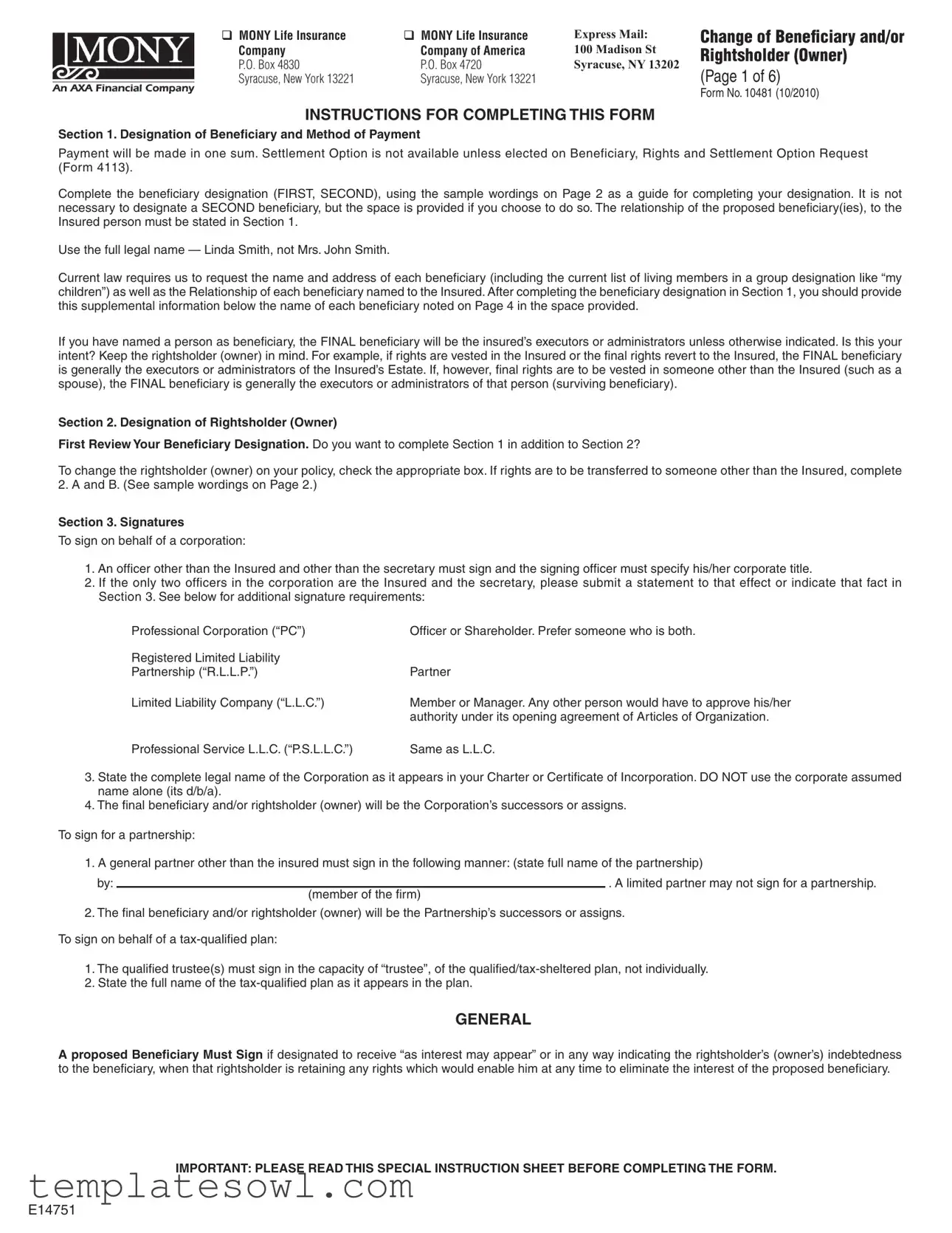(Page 3 of 6)
SAMPLE WORDINGS CONTINUED ..........
SINGLE PRIMARY RIGHTSHOLDER AND SINGLE CONTINGENT RIGHTSHOLDER
spouse, followed by child |
— Spouse, Mary Doe, if living, if not, daughter, Jane Doe |
SINGLE PRIMARY RIGHTSHOLDER AND GROUP CONTINGENT RIGHTSHOLDER |
spouse, followed by unnamed children |
— Spouse, Mary Doe, if living, if not, Insured’s children |
spouse, followed by named children |
— Spouse, Harry Doe, if living, if not, son, Frank Doe and daughter, Jane Doe |
GROUP PRIMARY RIGHTSHOLDERS AND SINGLE CONTINGENT RIGHTSHOLDER |
children, followed by spouse |
— Insured’s children, if none is living, spouse, Mary Doe |
General Information for Change in Ownership
•If the new Owner is a U.S. citizen, they must have a primary residence in the United States. If the person is a U.S.
Citizen but lives abroad, the change of ownership will require the approval of the AXA Equitable Anti-Money Laundering Office (AMLO).
•If the new Owner is not a U.S. citizen, they must have a primary resident address in the U.S. and have an unexpired visa or Green Card. Copies of the unexpired visa or Green Card must be submitted with this request. We will accept an unexpired visa in the following visa categories: A, E, G, H, I, K, L, N, NATO, P, R, S, T, TN, TD, U TPS or V. We will also need a copy of an unexpired visa and I-94 document.
•A Non-U.S. citizen that has a visitor’s visa, an expired Green Card or visa, no visa or has a visa in the following categories: B, C, D, F, J, M, Q, TWOV, will not be accepted as a new Owner and the ownership change must be declined under the AXA Financial Anti-Money Laundering policy.
•For Legal Resident Aliens: A copy of the unexpired Green Card or acceptable visa and I-94 form will be required to be submitted with the change of ownership request.
•For Trusts: Taxpayer Identification Number of the Trust and a copy of a Trust certification or significant pages and signature page of the Trust Agreement that proves the existence of the Trust, the name and date of the Trust Agreement,
as well as the name of the Trustee(s).
•For Partnerships: Pertinent page from the Partnership agreement that proves the Partnership exists and indicates the names of the Partners.
•For Private Corporations: Articles of Incorporation or copy of business license and documentation indicating the acting party has the authority to act on behalf of the Corporation.
•For Publicly Traded Corporations: No additional requirements need to be submitted.
•All non-resident individual and foreign business (Corporation, Trust, Partnership) new Owners require the approval of the AXA Equitable AMLO. In addition to the requirements outlined above, the AMLO also requires these new Owners to have a U.S. Bank account.
General Information for New Owner(s) concerning Taxpayer Identification Number
•Federal Law requires you to provide to us the correct Taxpayer Identification Number which matches your name.
•If you fail to provide the correct Taxpayer Identification Number, tax withholding may be required and penalties may apply.
•Your Taxpayer Identification Number is your Social Security Number if you are an individual and a U.S. person. A
U.S. person is a U.S. citizen, or a non-citizen of the United States who is a U.S. resident for tax purposes. If you are a foreign individual who is not eligible to apply for a Social Security Number, your Taxpayer Identification Number is your Individual Taxpayer Identification Number or “ITIN” issued by the IRS. If you are an entity (U.S. or foreign), your Taxpayer Identification Number is the Employer Identification Number or “EIN” issued by the IRS.
•In the case of a minor, the minor.s Social Security Number must be provided. If the minor does not have a Social
Security Number, the natural guardian for the minor owner may obtain one by applying to the Social Security Administration on Application Form SS-4. If the newly acquired number is not received by AXA Equitable/AXA Life and Annuity/MONY Life Insurance Company of America within 60 days, AXA Equitable/AXA Life and Annuity/MONY Life Insurance Company of America is required by law to withhold on any taxable interest being credited to the policy/ contract.



